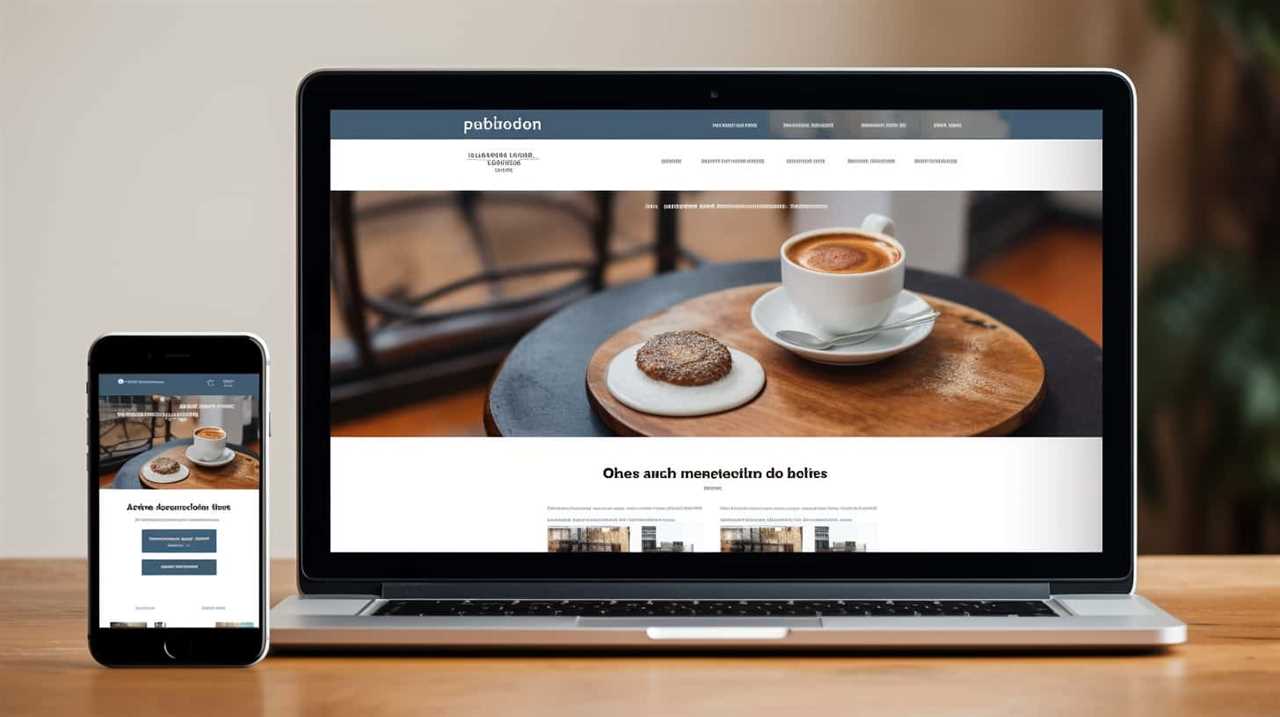Our expertise is committed to helping boutique wine shops achieve online presence.
In this article, we’ll explore the ins and outs of SEO, the essential tool for boosting your wine shop’s online visibility.
We’ll guide you through conducting keyword research, optimizing on-page elements, and creating high-quality content.
With our tips on user experience strategies and leveraging online reviews, you’ll be able to measure and analyze your SEO performance effectively.

Stay ahead of the game with the latest SEO trends and updates.
Let’s get started!
Key Takeaways
- Implementing effective SEO strategies is crucial for boutique wine shops to enhance visibility and attract potential customers.
- Higher rankings in search engine results pages (SERPs) establish credibility, gain a competitive advantage, and attract a wider audience.
- Conducting keyword research and optimization is essential to target the right audience and rank higher in search results.
- Local SEO and online reputation management play a vital role in improving visibility, attracting local customers, and building credibility through accurate business information and customer testimonials.
Understanding SEO for Boutique Wine Shops
In our journey to optimize digital rankings, we’ll delve into the intricacies of understanding SEO for boutique wine shops. To achieve success in the competitive online landscape, it’s crucial for boutique wine shops to implement effective SEO strategies. These strategies not only enhance visibility but also attract potential customers who are searching for specific products or services.
One key aspect of SEO for boutique wine shops is implementing local SEO for wineries. By targeting specific geographical areas, wineries can reach their local audience more effectively. This involves optimizing website content with local keywords, creating location-specific landing pages, and ensuring accurate business information across online directories.

Another important aspect is conducting thorough keyword research. By identifying the most relevant and high-traffic keywords, boutique wine shops can optimize their website content, meta tags, and URLs. This won’t only improve search engine rankings but also attract quality organic traffic.
Furthermore, optimizing the website’s technical aspects is essential. This includes improving site speed, ensuring mobile-friendliness, and optimizing metadata. These technical optimizations not only enhance the user experience but also improve search engine crawlability and indexing.
Importance of Digital Rankings for Wine Shops
Digital rankings play a crucial role in determining the online visibility and success of wine shops. In today’s digital age, where consumers rely heavily on search engines to find products and services, it’s essential for wine shops to have a strong online presence.
Here are four reasons why digital rankings are important for wine shops:

- Increased visibility: Higher rankings in search engine results pages (SERPs) ensure that your wine shop is more likely to be seen by potential customers. This increased visibility can lead to higher website traffic and ultimately more sales.
- Credibility and trust: When your wine shop appears on the first page of search results, it establishes a sense of credibility and trust in the minds of consumers. They’re more likely to view your shop as a reputable and reliable source for their wine needs.
- Competitive advantage: A higher digital ranking gives your wine shop a competitive edge over other shops that may not have optimized their online presence. This advantage can lead to increased market share and customer loyalty.
- Effective digital marketing strategies: By focusing on improving your digital rankings, you’re forced to implement effective digital marketing strategies such as search engine optimization (SEO) and online advertising. These strategies can help you reach a wider audience and attract more customers.
Understanding the importance of digital rankings for wine shops sets the stage for the next step: conducting keyword research for your wine shop.
Conducting Keyword Research for Your Wine Shop
When conducting keyword research for our wine shop, we focus on targeting relevant keywords that will attract our target audience.
We also optimize for long-tail keywords to increase our chances of ranking higher in search engine results.
Additionally, we analyze our competitors’ keywords to gain insights and stay competitive in the online wine market.

Targeting Relevant Keywords
To effectively target relevant keywords for our wine shop, we conduct thorough keyword research using a variety of tools and techniques. Here’s how we do it:
- Understand our target audience: We start by identifying our target market and understanding their preferences, interests, and search behaviors. This helps us tailor our keyword strategy to target local customers specifically.
- Analyze competitor keywords: We analyze the keywords used by our competitors to gain insights into their strategies and identify any gaps or opportunities.
- Use keyword research tools: We utilize keyword research tools like Google Keyword Planner, SEMrush, and Moz to generate a list of relevant keywords related to wine, wine types, and wine accessories.
- Optimize product descriptions: We incorporate these keywords into our product descriptions to improve search engine visibility and attract organic traffic to our online wine shop.
Long-Tail Keyword Optimization
For conducting keyword research for our wine shop, we focus on optimizing long-tail keywords that target specific preferences and interests of our local customers.
Long tail keyword research allows us to identify and incorporate niche phrases that are highly relevant to our products and customers. By optimizing product descriptions with these long-tail keywords, we can improve our visibility in search engine results and attract more qualified traffic to our website.
This approach ensures that we’re reaching the right audience and increasing our chances of conversion. We use data-driven methods to analyze search trends and identify the most effective long-tail keywords for our wine shop.

This mastery of long tail keyword optimization helps us stand out in the competitive online wine market.
Competitor Keyword Analysis
Our wine shop’s competitor keyword analysis is crucial for conducting effective keyword research. By analyzing our competitors’ keyword usage, we can gain valuable insights into their SEO strategies and apply them to our own.
Here are four competitor analysis techniques that can help us uncover hidden opportunities for our wine shop’s digital rankings:
- Identify top competitors: We need to identify the main players in our niche and analyze their online presence, including their website, content, and social media profiles.
- Analyze competitor keywords: By using tools like SEMrush or Ahrefs, we can discover the keywords our competitors are ranking for and the organic traffic they receive.
- Identify keyword gaps: By comparing our keyword list with our competitors’, we can identify keywords they’re ranking for that we’re not. This helps us uncover untapped keyword opportunities.
- Apply insights to our SEO strategy: Armed with this information, we can optimize our website, content, and metadata to target these keywords and improve our search engine rankings.
Optimizing On-Page Elements for Better SEO
We can optimize on-page elements to improve SEO for boutique wine shops. Two important aspects of on-page optimization are structured data optimization and meta tag optimization.

Structured data optimization involves adding specific markup to the HTML code of a website to provide search engines with more information about the content on the page. This can include details such as product information, reviews, and ratings. By implementing structured data, search engines can better understand and display relevant information in search results, increasing the visibility and click-through rates for boutique wine shops.
Meta tag optimization involves optimizing the meta tags on each page of a website. Meta tags are snippets of text that provide search engines with information about the content of a webpage. By optimizing meta tags, boutique wine shops can provide concise and relevant information about their products and services, improving the chances of appearing in relevant search results.
Both structured data optimization and meta tag optimization are crucial for improving the on-page SEO of boutique wine shops. By implementing these optimization techniques, boutique wine shops can increase their visibility in search engine results and attract more organic traffic to their websites.
Creating High-Quality Content for Wine Shop Websites
To create high-quality content for wine shop websites, it’s important to engage customers with informative and enticing descriptions of the wines available. Here are four key strategies to consider when creating compelling blog posts and maximizing website engagement:

- Know your audience: Understand the preferences and interests of your target customers. Research their wine preferences and consumption habits to tailor your content accordingly. This will help you create blog posts that resonate with your audience and keep them coming back for more.
- Tell stories: Wine isn’t just a drink; it’s an experience. Share the stories behind the wines you offer, including the winemakers, the vineyards, and the regions they come from. By painting a vivid picture of the wine’s origin and journey, you can captivate your readers and make them feel a deeper connection to the product.
- Provide expert advice: Position yourself as a trusted authority in the wine industry by offering valuable tips and recommendations. Share food pairing suggestions, serving techniques, and information about different wine varietals. This won’t only educate your customers but also establish your credibility in the field.
- Use multimedia: Enhance your content with visually appealing images and videos. Showcase the wines in action, such as pouring, swirling, and tasting. This will create a more immersive and engaging experience for your website visitors.
Building Backlinks to Boost SEO Rankings
In order to improve our SEO rankings, we can enhance our website’s visibility by building backlinks through strategic partnerships and collaborations. One effective way to do this is through influencer partnerships. By partnering with influencers in the wine industry, we can tap into their large and engaged audience, gaining exposure and credibility for our boutique wine shop. These influencers can share our content, link to our website, and mention us in their social media posts, helping to boost our website’s visibility and authority.
Another valuable strategy for building backlinks is through guest blogging opportunities. By reaching out to relevant wine blogs and websites, we can offer to write high-quality guest posts that provide valuable information and insights to their audience. In return, we can include a link back to our website within the article, driving traffic and improving our SEO rankings.
When building backlinks, it’s important to prioritize quality over quantity. Focus on building links from reputable websites with high domain authority, as these will have a greater impact on our SEO rankings. Additionally, regularly monitoring and analyzing our backlink profile can help us identify any low-quality or spammy links that may be harming our SEO efforts.
Leveraging Local SEO for Boutique Wine Shops
When it comes to boosting the digital rankings of boutique wine shops, leveraging local SEO is essential.

One key aspect of this is optimizing Google My Business to ensure accurate and up-to-date information is provided to potential customers.
Local keyword targeting is also crucial, as it allows wine shops to appear in search results when users are looking for specific products or services in their area.
Additionally, building online reviews can help establish credibility and improve visibility in local search results.
Optimizing Google My Business
We actively optimize our Google My Business listing to enhance local SEO for our boutique wine shop. Optimizing Google My Business is crucial for increasing our online visibility and attracting local customers. Here are four key strategies we implement:

- Accurate Business Information: We ensure that our business name, address, and phone number (NAP) are consistent across all platforms to enhance our local search rankings.
- Google My Business Posts: We regularly create posts on our Google My Business listing, highlighting new wine arrivals, upcoming events, and special promotions. This helps to engage our audience and improve our visibility in local search results.
- Customer Reviews: We actively encourage our customers to leave reviews on our Google My Business page. Positive reviews not only boost our reputation but also improve our search rankings.
- Photos and Videos: We regularly update our Google My Business listing with high-quality photos and videos showcasing our wine selection and ambiance. This attracts potential customers and enhances our online presence.
Local Keyword Targeting
To leverage local SEO for boutique wine shops, it’s essential to target local keywords. Local keyword targeting involves optimizing your website and content to rank higher in local search results. By incorporating geo targeted keywords, such as the name of your city or neighborhood, you can increase your visibility to potential customers in your area.
This can be done through on-page optimization, including optimizing page titles, meta descriptions, headers, and content with relevant local keywords. Additionally, creating location-specific landing pages and listing your business on online directories can further improve your local search optimization.
Building Online Reviews
Building online reviews is a crucial step in leveraging local SEO for boutique wine shops. Online reviews not only help to improve your shop’s online reputation but also play a significant role in local search rankings.
Here are four strategies to generate customer testimonials and encourage customer feedback:

- Ask for reviews: Reach out to satisfied customers and politely ask them to leave a review on platforms like Google My Business, Yelp, and Facebook.
- Provide incentives: Offer a small discount or a free sample to customers who leave a review. This can be an effective way to encourage more people to share their experience.
- Respond to reviews: Engage with customers by responding to both positive and negative reviews. Show that you value their feedback and are committed to providing excellent service.
- Monitor and manage reviews: Regularly check and respond to new reviews. Address any negative feedback promptly and professionally, demonstrating your dedication to customer satisfaction.
Utilizing Social Media for SEO Success
Maximizing social media engagement is key to achieving SEO success for boutique wine shops. In today’s digital age, social media platforms play a crucial role in increasing brand visibility, driving website traffic, and improving search engine rankings.
To leverage influencer marketing, boutique wine shops can collaborate with industry influencers to promote their products and services. By partnering with influencers who have a strong online presence and a large following, wine shops can reach a wider audience and gain credibility in the market.
Additionally, utilizing video content is a powerful strategy to engage and captivate social media users. Wine shops can create informative and visually appealing videos that showcase their unique offerings, such as vineyard tours, wine tastings, and food pairing recommendations. These videos can be shared on various social media platforms, attracting more viewers and generating organic traffic to the website.
Mobile Optimization for Wine Shop Websites
When it comes to mobile optimization for wine shop websites, there are three key points to consider.

Firstly, responsive web design is crucial to ensure that your website looks and functions well on all devices, from smartphones to tablets.
Secondly, speed and performance are important factors in providing a seamless user experience, as slow-loading pages can lead to high bounce rates.
Lastly, user-friendly navigation is essential for mobile users, as they need to be able to easily find and access the information they’re looking for.
Responsive Web Design
Our wine shop prioritizes responsive web design to ensure optimal mobile optimization for our website. In today’s digital landscape, having a mobile-friendly website is crucial for success. Here are four reasons why responsive web design is essential for boutique wine shops:

- Improved user experience: Responsive web design ensures that our website adapts to different screen sizes and devices, providing a seamless and enjoyable browsing experience for our customers.
- Higher search engine rankings: Search engines like Google prioritize mobile-friendly websites in their search results. By implementing responsive web design, we increase our chances of ranking higher and attracting more organic traffic.
- Increased mobile traffic: With the increasing use of smartphones, a large portion of our target audience accesses the internet through mobile devices. By optimizing our website for mobile, we tap into this growing market and generate more mobile traffic.
- Better conversion rates: A responsive website design enhances user engagement and encourages visitors to take action, such as making a purchase or contacting us. This ultimately leads to higher conversion rates and increased revenue for our wine shop.
Speed and Performance
We prioritize optimizing the speed and performance of our wine shop website for mobile users.
Improving website speed and optimizing website performance are crucial for providing a seamless user experience and ensuring that potential customers can easily navigate and engage with our site.
Mobile optimization is especially important as more and more people are using their smartphones to browse and make purchases online.
Studies have shown that a slow-loading website can lead to high bounce rates and loss of potential customers.

By focusing on improving website speed, we can reduce page load times and enhance the overall performance of our site.
This can lead to higher search engine rankings, increased organic traffic, and ultimately, more conversions and revenue for our boutique wine shop.
User-Friendly Navigation
To ensure a smooth browsing experience for potential customers, optimizing the navigation of our wine shop website is essential for mobile users. Here are four key ways we can improve user engagement and create a mobile-friendly design:
- Simplify the menu: Make sure the menu is easy to navigate and understand, with clear categories and subcategories.
- Implement a search bar: Allow users to quickly search for specific wines or types of wine, making it easier for them to find what they’re looking for.
- Use clear and intuitive buttons: Make sure all buttons are easy to tap and understand, with clear labels that indicate their purpose.
- Optimize for speed: Ensure that the website loads quickly on mobile devices, as slow loading times can lead to frustration and higher bounce rates.
Implementing User Experience (UX) Strategies
Implementing user experience (UX) strategies enhances the digital presence and overall satisfaction of boutique wine shop customers. By focusing on UX design principles, conducting UX testing and optimization, wine shops can create a seamless and enjoyable online shopping experience for their customers.

To effectively implement UX strategies, wine shops should consider the following factors:
| Factor | Description |
|---|---|
| Clear navigation | Ensure that the website is easy to navigate, with intuitive menus and clear pathways to different sections. |
| Responsive design | Optimize the website for mobile devices, ensuring that it is accessible and user-friendly on all screen sizes. |
| Streamlined checkout process | Simplify the checkout process by minimizing the number of steps required and offering multiple payment options. |
By implementing these UX strategies, wine shops can improve their digital presence and attract more customers. Additionally, a positive user experience leads to increased customer satisfaction and loyalty.
Transitioning into the subsequent section about utilizing online reviews for SEO advantage, it is important to note that customer feedback plays a crucial role in enhancing the user experience. Online reviews provide valuable insights into the strengths and weaknesses of a wine shop’s digital presence, allowing them to make necessary improvements and further optimize their SEO efforts.
Utilizing Online Reviews for SEO Advantage
Leveraging online reviews for SEO advantage involves optimizing our wine shop’s digital presence based on customer feedback and insights. By utilizing customer testimonials and managing our online reputation, we can improve our search engine rankings and attract more customers to our boutique wine shop.

Here are four ways we can utilize online reviews for SEO advantage:
- Monitor and respond to reviews: Actively monitor online review platforms such as Yelp, Google My Business, and TripAdvisor. Respond to both positive and negative reviews to show that we value customer feedback and are committed to providing excellent service.
- Encourage customers to leave reviews: Ask satisfied customers to leave reviews on our website or on review platforms. Positive reviews can help improve our search engine visibility and build trust with potential customers.
- Incorporate review snippets on our website: Displaying snippets of positive reviews on our website can improve our search engine rankings. These snippets provide valuable content for search engines to crawl and index.
- Optimize review platforms: Ensure that our business information, such as our address and phone number, is consistent across all review platforms. This consistency helps search engines understand and validate our business information.
Measuring and Analyzing SEO Performance
We measure and analyze our SEO performance to understand the effectiveness of our digital strategies and make data-driven decisions for improving our boutique wine shop’s online visibility. Measuring SEO success is crucial for determining whether our efforts are paying off and identifying areas for improvement.
One of the key metrics we track is keyword rankings. By monitoring how our targeted keywords rank in search engine results pages (SERPs), we can gauge our website’s visibility and organic traffic potential.
To track keyword rankings, we use various tools that provide accurate and up-to-date data. These tools allow us to monitor our progress over time, identify fluctuations in rankings, and compare our performance against competitors. By analyzing this data, we can uncover valuable insights that guide our SEO strategy.

In addition to keyword rankings, we also analyze other performance indicators such as organic traffic, click-through rates, and conversion rates. These metrics help us assess the overall impact of our SEO efforts on our boutique wine shop’s online presence and revenue generation.
Staying up to Date With SEO Trends and Updates
To stay current with SEO trends and updates, we actively stay informed about the latest developments in digital marketing. Here are four key areas that we focus on to ensure we’re up to date with the ever-changing SEO landscape:
- Voice search optimization: With the rise of virtual assistants like Siri and Alexa, optimizing for voice search has become crucial. We stay updated on the latest techniques and strategies to ensure our website is voice search-friendly. This includes using long-tail keywords, creating conversational content, and optimizing for featured snippets.
- Video content marketing: Video has become a powerful tool for engaging with customers and driving traffic to our website. We stay informed about the latest trends and best practices in video content marketing. This includes creating engaging and shareable videos, optimizing video metadata, and leveraging video platforms like YouTube and Vimeo.
- Mobile optimization: With the majority of internet users accessing websites through mobile devices, mobile optimization is more important than ever. We stay updated on the latest mobile optimization techniques, such as responsive design, mobile site speed optimization, and mobile-friendly user experience.
- Algorithm updates: Search engine algorithms are constantly evolving, and staying updated on algorithm updates is essential to maintain our SEO rankings. We stay informed about major algorithm updates from search engines like Google and make necessary adjustments to our SEO strategies.
Conclusion
In conclusion, implementing effective SEO strategies is crucial for boutique wine shops looking to improve their digital rankings.
By conducting thorough keyword research, optimizing on-page elements, creating high-quality content, and utilizing user experience strategies, wine shops can attract more online visitors and increase their chances of converting them into customers.

For example, a boutique wine shop in Napa Valley saw a 30% increase in website traffic and a 20% boost in online sales after implementing a comprehensive SEO plan.
Stay updated with SEO trends and updates to stay ahead in the competitive wine industry.









